Last week, I wrote about the way groups like CivicLex extract a form of community rent in which they leverage their access to art and grant-money to control the tenor and direction of everyday city life. The article presented the non-profit’s Artist-in-Residence rental agreement as a comparatively smaller form of rentier capitalism than the proposal presently before City Council to give the mysterious development company Astana, LLC a $40 million Industrial Revenue Bond to construct a boutique hotel at the back edge of Rupp Arena.
To really get a sense of how CivicLex leverages its assets to assert community control, though, it is helpful to compare the non-profit’s recent rental agreement with the city against a more similar rental arrangement: the one between low-income Julietta Market vendors and their non-profit and for-profit landlords, NoLi CDC and property owner Chad Needham.
Rent on Pam Miller
At $8,307 for the 13-month term of the lease, rent on CivicLex’s 640 square foot office in the Pam Miller Downtown Arts Center equates to $639 per month. Another way to state this is that the city’s lease charges CivicLex $12 per square foot per year.
Here is that rental math visually.
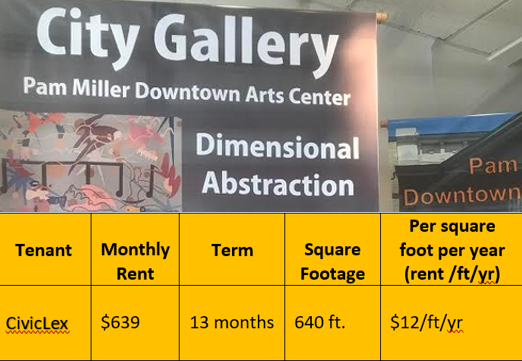
This is quite the city deal. The Pam Miller Downtown Arts Center sits on valuable downtown property. Not only is it katty-corner from City Hall, Pam Miller sits amidst nearly a billion dollars of recent public investment.
A half-block west on Main Street is the newly built CityCentre office towers. Another half-block further is the renovated 21C Modern Art Hotel and the more-recently renovated Old Courthouse. Here’s a picture to show how close these big-ticket projects are located to Pam Miller.

Travel west yet another block and there is the Rupp Arena and Convention Center upgrade. One can return to the Pam Miller Arts Center on the about-to-be-completed Town Branch Commons hike/bike trail, passing the newly installed Suffragist statuary along the way.
Pardon the local geography, but here’s the point: after close to a billion dollars of public upgrades explicitly made in the name of “increasing” downtown value, no Main Street rent is or should be so low as $12/foot/year. Whether it cops to it or not, the city is subsidizing CivicLex’s posh Main Street address (along with, possibly, the other arts-based tenants of the city-built Pam Miller Arts Center).
I’m not against subsidizing community groups in need, or even subsidizing some of the arts, but is CivicLex and its program to embed 3 artists into city government actually in need of those limited subsidies…that Main Street address…for that sort of project?
Despite claims to represent the margins, the non-profit is hardly marginalized. Not only is its founder, Richard Young, a well-established, if relatively young, non-profit insider who has worked regularly with elected and unelected local power-players, his non-profit has leveraged that personal civic power into national grants from Facebook, the National Endowment for the Arts, LenFest, the Knights Foundation, and the like.

The specific project for which CivicLex is receiving the Pam Miller lease, a gambit to leverage national grant money with local matching funds in order to embed 3 CivicLex curated “artists” into city departments, is not in any way community-driven, nor does its bland aim really seem to serve a vital need for filling limited city space.
The city’s CivicLex art discount seems to be a case much akin to a horse-polo player ponying up to the city for a discount $40 million loan to help build a boutique hotel. These are small and large city-subsidies handed out to ensure that the asset-rich at all levels remain in power.
Julietta’s affordable rates
Consider CivicLex’s discounted Main Street rent against that being charged to the low-income entrepreneurs setting up shop a mile north in the much-celebrated Julietta Market, located inside the Chad Needham-purchased former LexTran headquarters now known as the Grey Line Station.
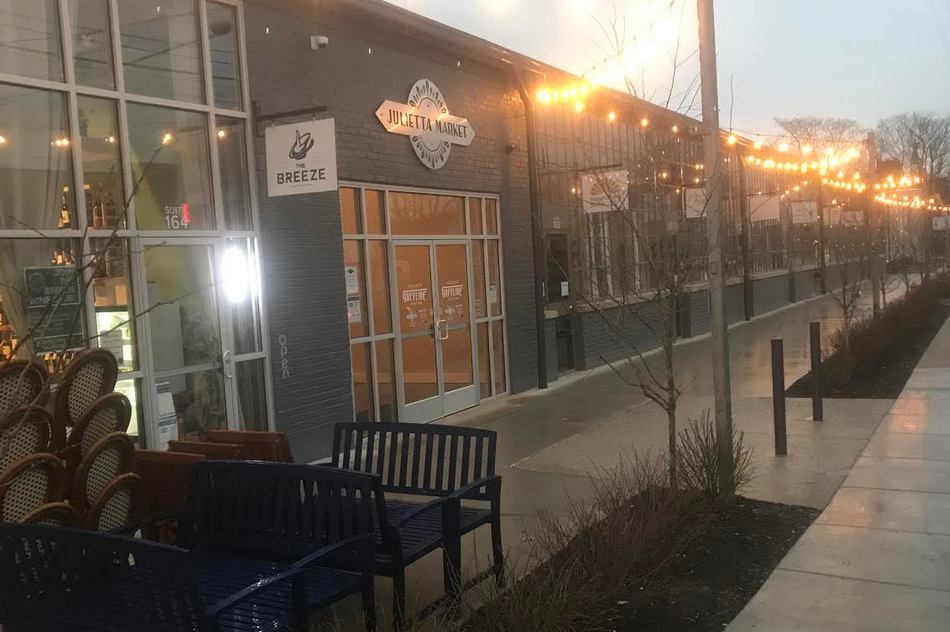
Julietta Market is the product of a 2013 grant written by CivicLex CEO Richard Young during his time running the NoLi CDC, a front-group for real estate interests who were engaged in northside gentrification. The Julietta grant was among a handful of significant grant-hauls (co-authored with NoLi ambassador and major land-owner Griffin Van Meter) that made Young’s reputation on the civic non-profit scene as an architect of the northside. These were Young’s touchstone community assets–universally lauded, rarely looked at closely–that allowed him to set off in 2017 and startup his own non-profit foundation, CivicLex.
Ostensibly, the Julietta grant was meant as a synergistic complement to Young’s other two landmark grant-funded projects: (1) a monthly “Night Market” that NoLi hosted on a closed-off area street, and (2) the “Luigart Maker’s Spaces” development, which used both foundation and city affordable housing money to purchase much of the nearby low-income York Street in order to create affordable housing for artists.
If both of these early projects were explicitly designed to attract artists into the gentrifying neighborhood, the $550,000 Julietta grant would begin the work to employ them.
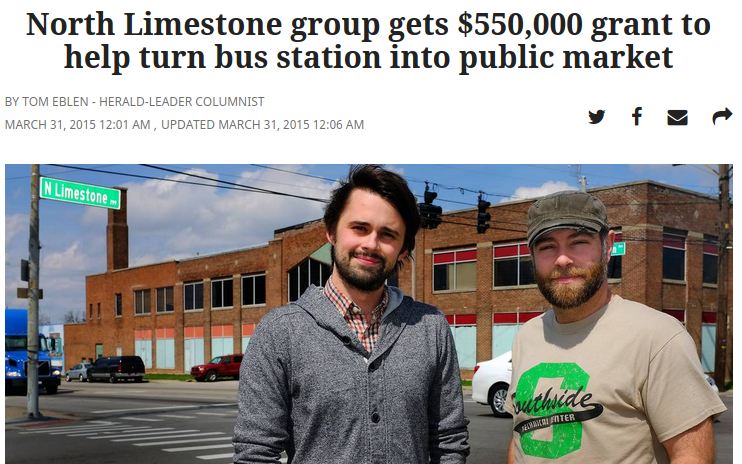
In one among many signs of the profligate, dunce-cap way that national foundations hand out grants to people with the right connections, NoLi CDC was awarded its half-million dollar grant despite not owning the LexTran building, nor having any means with which to acquire the building! (After NoLi-connected landlords pushed out the city’s bus operator, LexTran, by having the building placed on the National Historic Register, the building had stood vacant for over a half-decade.)
Six years later, during which time Young left NoLi CDC for his spinoff non-profit CivicLex/ProgressLex, the half-million dollar Julietta grant is finally being used. The longtime northside developer who eventually bought the vacant building, Chad Needham, has partnered with NoLi CDC and its foundation money to rent out a portion of the building’s interior as a sort of peddler’s mall of cubicle-size shops.
I am unclear on the specifics, but it appears that NoLi CDC pays a set amount to Needham as rent for the interior market space known as Julietta. In turn, NoLi then charges the Julietta vendors rent on a variety of cubicle sizes, using their half million dollar grant to subsidize any low income and minority renters. Think of it as trickle-down non-profit economics, a basic component of Neoliberal Grant Writing 101.
Here is the market rate and subsidized rent that marginalized Julietta vendors pay to NoLi CDC and thence to Needham.

The Julietta rents read a bit like an Obamacare marketplace menu offering for health insurance. Interested Julietta entrepreneurs certainly have lots of options, all of which can be discounted for marginalized folks. Further, the list prices all seem affordable ($250 month!). Dig a bit deeper, though, and things don’t look so nice.
As an example, let’s take a closer look at the monthly rent on a 8×8 foot cubicle at the Julietta Market. NoLi CDC lists a Market Rate rent of $425 month and an Affordable Rate of $275. This sounds like a great discount–big shout-out to the white progressives at NoLi/CivicLex/ProgressLex for securing that half-million dollar national foundation grant to make Chad Needham’s Grey Line development project a community-buffing reality!

Dig a bit deeper, and at 64 square feet, NoLi/Needham are charging “market rate” rents that amount to a staggering $79.50 per square foot per year. The “affordable” rental rate is a still-staggering $51.50 per square foot per year. Here is that Julietta rental math visually.
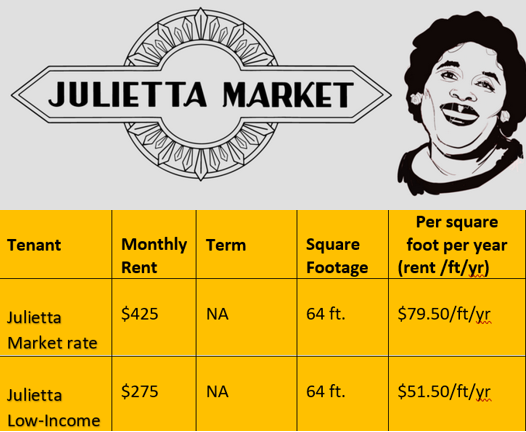
To put this rental figure into perspective, take a look at the rental costs for the recently-completed, city-subsidized CityCentre project, where high-end corporate businesses like the billion-dollar company Rubicon just relocated. Rental costs for this hoity-toity Main Street neighbor of CivicLex amount to just $26.15/ft/year, about twice as affordable as the “affordable” rates offered by NoLi and Needham to actually-existing-low-income-entrepreneurs hawking their goods in their comparatively downscale space inside the Grey Line.
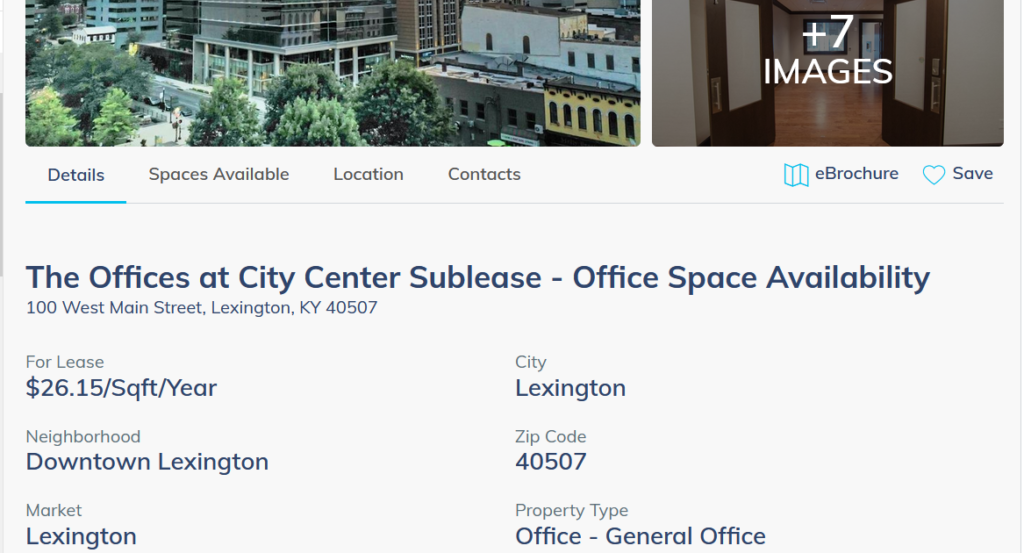
Or recall where this article started, with the CivicLex discount lease on their Main Street Artist-in-Residency office: $12 per square foot per year. To get access to 640 square feet of office space like CivicLex, a low-income vendor at Julietta would have to rent a total of ten 8×8 spaces. The monthly check that “low-income” Julietta vendors renting that size space would write? $2,750–and it’d come straight out of their pockets.
Here is that Julietta/CivicLex comparison visually.
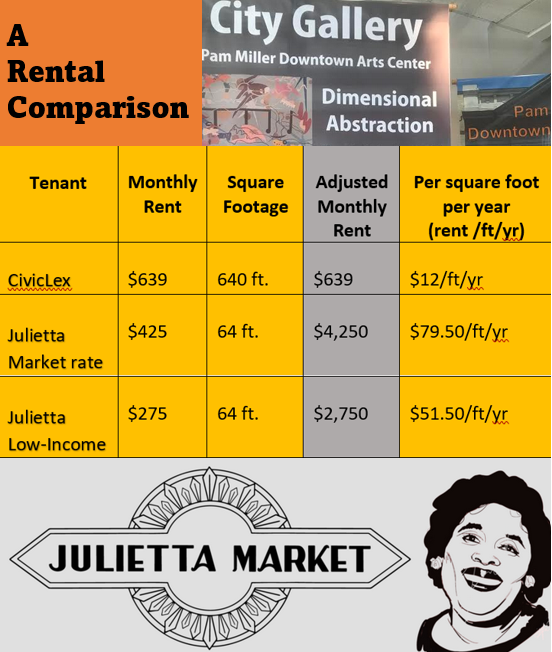
CivicLex, it should be stated, will not even pay that discount out of their own pockets. The nonprofit will pay the rent on its Pam Miller Arts Center office out of its $75,000 NEA grant. In fact, subtract the $45,000 cost for paying its artists, the $8,307 for the Main Street lease, and the $4,500 in supplies for the artists, and CivicLex is making off with about $18,000 in profit just for their non-value-added “management” of the artist program. (This figure rises to $33,000 profit when one factors in a $15,000 city support grant for the Artist-in-Residence program.)
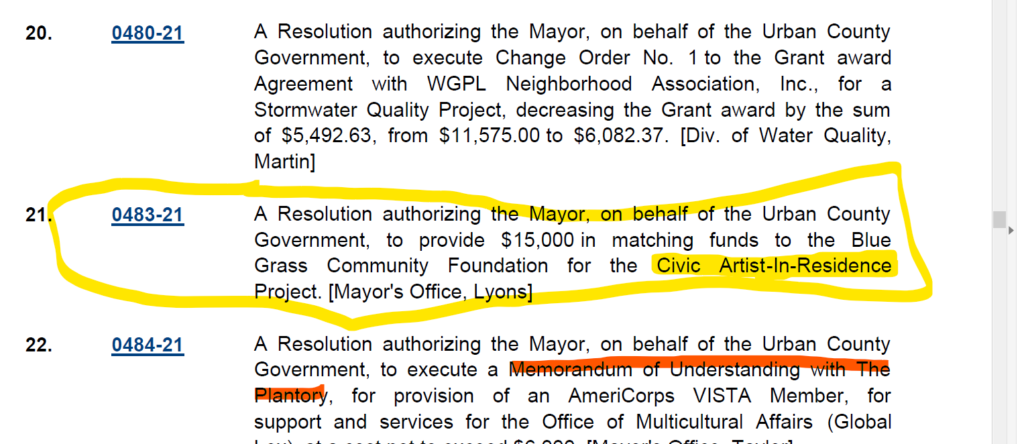
The CivicLex deal is so good, apparently, that the non-profit was able last month to splurge on the pop-up rate for a stall at Julietta to promote its artist-in-residence program, presumably to let the fleeced low-income vendors there know that people in city hall are thinking about them. One wonders if they demanded the “Market Rate” for their pop-up ($50-100 a day)….or if they wrangled the “Affordable Rate” of $20-40 from their former colleagues.

Mainly, rentier capitalism is about using the ownership of assets—Distillery District land, a license to run a cable company, intellectual property rights on a TV show—to limit competition and thereby further enrich yourself. CivicLex’s rent scheme, like NoLi CDC’s rent scheme, involves a different set of assets: special access to city government and grant-writing foundations.
The Julietta “affordable” rates charged by NoLi CDC and Chad Needham showcase who loses when nonprofits extract a community rent.
The CivicLex rental agreement to embed 3 of its chosen artists into important city departments as a serious gambit to draw excluded communities into the civic process, meanwhile, shows the sort of people and ideas that have long benefited from that community rent.

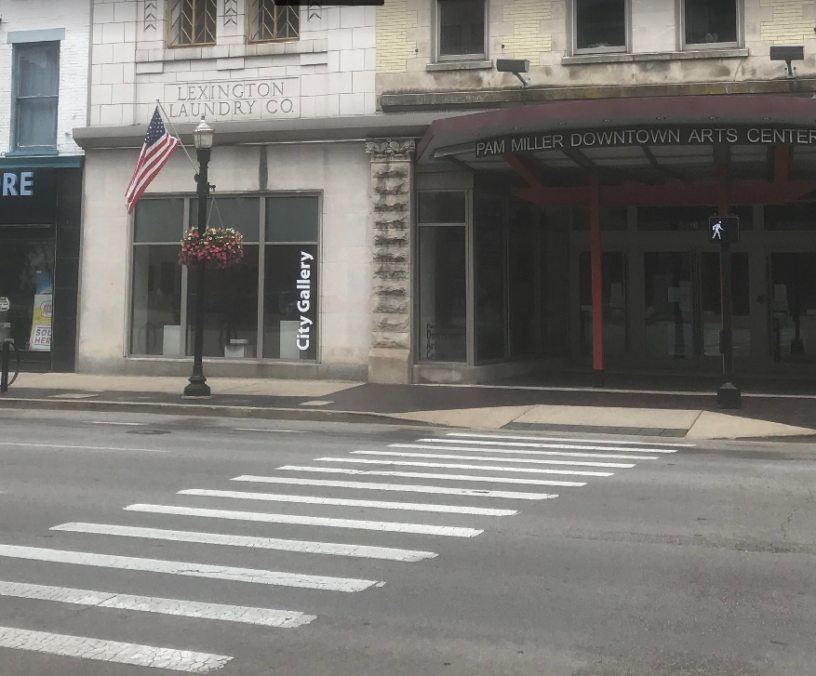



Leave a Reply